The grief does not end for family, friends and brothers in arms of servicemen and women still missing in action or kept as prisoners of war in a foreign country.That’s what Retired Lt. Gen. William Webster, former 3rd Infantry Division commander, told soldiers and guests attending Friday’s POW/MIA ceremony at Fort Stewart’s Vietnam Memorial. Other special guests included current 3rd ID commander Maj. Gen. Mike Murray and his wife, Jane, 3rd ID Command Sgt. Maj. Edd Watson and former Korean War POW, David Mills with his wife of 58 years, Shirley.The ceremony was sponsored by the Vietnam Veterans of America, Chapter 789 and supported by American Legion Posts 168 and 321, Disabled American Veterans chapter 46 and the Coastal Empire Chapter of the Association of the United States Army.Webster said he was honored to be asked to speak at the ceremony. He remembered when the Vietnam Memorial was being built at the museum in 2003, noting that it’s inspiring whenever he drives by and sees the UH-1H Huey helicopter and POW/MIA flag, which flies 24-hours a day, seven days a week.“Today is a day to remember our POWs, current and former, and our missing in action,” Webster said. “(It’s also) a time to reaffirm our pledge as a nation to account for every killed in action, missing in action and POW service member — all of those whose remains are not yet on American soil.”Webster said he was in the Pentagon on Sept. 11, 2001, when a plane hit not 30 yards from where he was working.
POWs, MIAs remembered
Annual ceremony held on Fort Stewart


Sign up for our e-newsletters